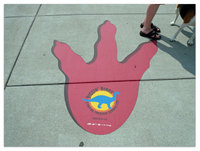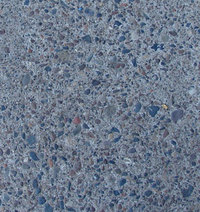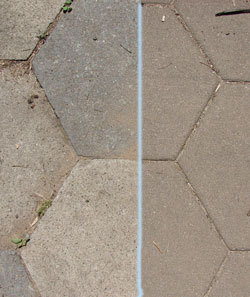By Erik Hare
In a city like Saint Paul, there are stories everywhere. Sometimes they can be found on a plaque on a building and sometimes they fall out of a conversation with a stranger. If you look hard enough, there are even a few stories in the sidewalk under your feet.
building and sometimes they fall out of a conversation with a stranger. If you look hard enough, there are even a few stories in the sidewalk under your feet.
Hardly anyone takes the time to even notice a sidewalk. They are just there, a part of the city that we depend on. But by being there, they can tell us something about the times long gone when they were put in place and everyone started to rely on them. It’s simply a matter of noticing them in ways you never have before.
Poured concrete was not generally used for sidewalks until a century ago, so any sidewalk cannot be older than about 1900. Before that time, crushed rock was the most common kind of “walk” found even in cities. It was somewhat durable, but still prone to become muddy when it rained. Downtowns and a few vocal neighborhoods were able to get cast cement pavers. In the early 1900s many of these sidewalks were replaced with durable poured-in-place concrete.
Con crete is made from cement, water, and an aggregate mixed together. When poured into a sidewalk, it was very fashionable in the early 1900s to use an “exposed aggregate” system. This simply means that the multi-colored pebbles that were used as an aggregate are placed on top to give the sidewalk texture and the flair of a mosaic, like the picture here. This was probably favored because it was replacing a crushed rock paths, and they wanted the same look. Sidewalks like this were made from 1900 until about 1940; the example here is from Selby Avenue near Western.
crete is made from cement, water, and an aggregate mixed together. When poured into a sidewalk, it was very fashionable in the early 1900s to use an “exposed aggregate” system. This simply means that the multi-colored pebbles that were used as an aggregate are placed on top to give the sidewalk texture and the flair of a mosaic, like the picture here. This was probably favored because it was replacing a crushed rock paths, and they wanted the same look. Sidewalks like this were made from 1900 until about 1940; the example here is from Selby Avenue near Western.
The other thing to note is the color of the sidewalk, which is dark and slightly brown. Older sidewalks in Saint Paul are somewhat brown, which is a very unusual color for otherwise grey cement. It probably was made that way deliberately.
After about 1940, smoother sidewalks became more fashionable. They certainly hold up better, and are easier to keep clean. A dark but smooth sidewalk probably dates from between 1940 into the 1950s. As time goes on, the color became lighter – partly because newer sidewalks aren’t as dirty. Even without the dirt, old concrete is darker and Saint Paul’s modern concrete is nearly white in color.
 More recently, a lot of different things have started to happen with sidewalks. The picture here shows tiles set in Irvine Park in 1893 on the left, and the cast in place “Bomanite” replacements from 1978 are on the right. The new ones match in size, but not in color and texture. Bomanite allows molded shapes such as brick to be made easily with colored concrete. You can also see modern sidewalks made with the same rainbow-mosaic that they were made with a century ago.
More recently, a lot of different things have started to happen with sidewalks. The picture here shows tiles set in Irvine Park in 1893 on the left, and the cast in place “Bomanite” replacements from 1978 are on the right. The new ones match in size, but not in color and texture. Bomanite allows molded shapes such as brick to be made easily with colored concrete. You can also see modern sidewalks made with the same rainbow-mosaic that they were made with a century ago.
The stories underfoot are a bit different than the stories you might hear anywhere else on the street. For one thing, you have to know how to read them. But if you look hard enough you can see them, as long as you remember that the sidewalk begins underneath your feet.
